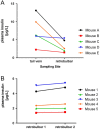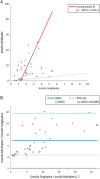Control of (pre)-analytical aspects in immunoassay measurements of metabolic hormones in rodents
- PMID: 29540488
- PMCID: PMC5881432
- DOI: 10.1530/EC-18-0035
Control of (pre)-analytical aspects in immunoassay measurements of metabolic hormones in rodents
Abstract
The measurement of circulating hormones by immunoassay remains a cornerstone in preclinical endocrine research. For scientists conducting and interpreting immunoassay measurements of rodent samples, the paramount aim usually is to obtain reliable and meaningful measurement data in order to draw conclusions on biological processes. However, the biological variability between samples is not the only variable affecting the readout of an immunoassay measurement and a considerable amount of unwanted or unintended variability can be quickly introduced during the pre-analytical and analytical phase. This review aims to increase the awareness for the factors 'pre-analytical' and 'analytical' variability particularly in the context of immunoassay measurement of circulating metabolic hormones in rodent samples. In addition, guidance is provided how to gain control over these variables and how to avoid common pitfalls associated with sample collection, processing, storage and measurement. Furthermore, recommendations are given on how to perform a basic validation of novel single and multiplex immunoassays for the measurement of metabolic hormones in rodents. Finally, practical examples from immunoassay measurements of plasma insulin in mice address the factors 'sampling site and inhalation anesthesia' as frequent sources of introducing an unwanted variability during the pre-analytical phase. The knowledge about the influence of both types of variability on the immunoassay measurement of circulating hormones as well as strategies to control these variables are crucial, on the one hand, for planning and realization of metabolic rodent studies and, on the other hand, for the generation and interpretation of meaningful immunoassay data from rodent samples.
Keywords: ELISA; assay performance; assay validation; endocrine factors; immunoassay; insulin; metabolism; mice; multiplex; plasma hormones; variability.
© 2018 The authors.
Figures



Similar articles
-
A guide for measurement of circulating metabolic hormones in rodents: Pitfalls during the pre-analytical phase.Mol Metab. 2012 Aug 9;1(1-2):47-60. doi: 10.1016/j.molmet.2012.07.004. eCollection 2012. Mol Metab. 2012. PMID: 24024118 Free PMC article.
-
Influence of pre-analytical conditions on the measurement of components of the GH/IGF axis in rats.Growth Horm IGF Res. 2013 Oct;23(5):141-8. doi: 10.1016/j.ghir.2013.05.001. Epub 2013 Jun 15. Growth Horm IGF Res. 2013. PMID: 23773927
-
Human Milk Metabolic Hormones: Analytical Methods and Current Understanding.Int J Mol Sci. 2021 Aug 13;22(16):8708. doi: 10.3390/ijms22168708. Int J Mol Sci. 2021. PMID: 34445437 Free PMC article. Review.
-
Novel bone metabolism-associated hormones: the importance of the pre-analytical phase for understanding their physiological roles.Endocrine. 2017 Jun;56(3):460-484. doi: 10.1007/s12020-017-1239-z. Epub 2017 Feb 8. Endocrine. 2017. PMID: 28181144 Review.
-
Validation of immunoassay for protein biomarkers: bioanalytical study plan implementation to support pre-clinical and clinical studies.J Pharm Biomed Anal. 2011 Jul 15;55(5):869-77. doi: 10.1016/j.jpba.2011.03.033. Epub 2011 Mar 29. J Pharm Biomed Anal. 2011. PMID: 21530130
Cited by
-
A siRNA mediated hepatic dpp4 knockdown affects lipid, but not glucose metabolism in diabetic mice.PLoS One. 2019 Dec 3;14(12):e0225835. doi: 10.1371/journal.pone.0225835. eCollection 2019. PLoS One. 2019. PMID: 31794591 Free PMC article.
-
The Use of Antibody Arrays in the Discovery of New Plasma Biomarkers for Endometriosis.Reprod Sci. 2020 Feb;27(2):751-762. doi: 10.1007/s43032-019-00081-w. Epub 2020 Feb 3. Reprod Sci. 2020. PMID: 32016799
-
Liver-Specific Knockdown of Class IIa HDACs Has Limited Efficacy on Glucose Metabolism but Entails Severe Organ Side Effects in Mice.Front Endocrinol (Lausanne). 2020 Aug 28;11:598. doi: 10.3389/fendo.2020.00598. eCollection 2020. Front Endocrinol (Lausanne). 2020. PMID: 32982982 Free PMC article.
References
-
- Morgan CR, Lazarow A. Immunoassay of insulin: two antibody system: plasma insulin levels of normal, subdiabetic and diabetic rats. Diabetes 1963. 12 115–126. (10.2337/diab.12.2.115) - DOI
Publication types
LinkOut - more resources
Full Text Sources
Other Literature Sources

